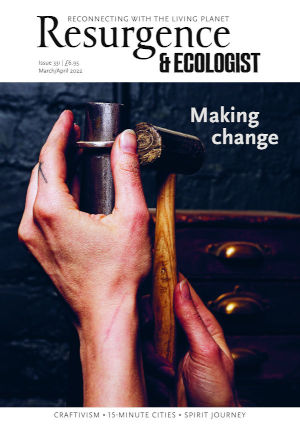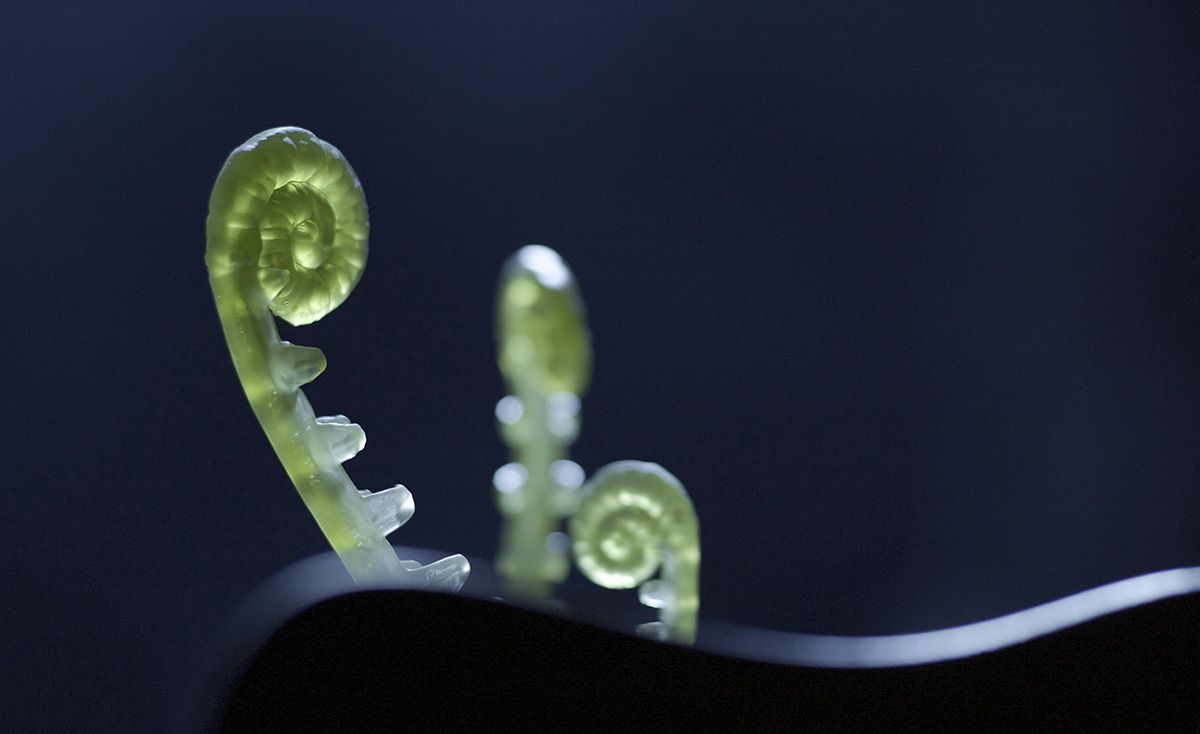“What does it mean to investigate, celebrate, and make art about the micro, often ignored, living matter that our ecosystems depend upon?” ask curatorial duo Neena Percy and Lizzy Drury, who work together under the name Hot Desque. “While billionaires look to the stars for future solutions or outright avoidance of the climate crisis, we wanted to think about what it means to be ‘terrestrial’.”
Hot Desque’s project Terrestrial Act is an exploration of the earthly, from planetary to microscopic scales. The project has been developed over the course of several ‘acts’: an exhibition on stage at the Theatre Royal, Newcastle; a film that was shown at CCA Glasgow, Lunchtime Gallery and the NewBridge Project; and an exhibition at Thames-Side Studios Gallery in London. A special online screening of the film is available for Resurgence & Ecologist readers. The link is at the end of this article.
The ‘actors’ in this film are sculptures by six artists: Sam Carvosso, Anna Reading, Davinia-Ann Robinson, Hannah Rowan, Harry Smithson, and Giorgio van Meerwijk. Hot Desque populated the stage of the Theatre Royal Newcastle with these works, using elements of set design and scenery to create an uncertain landscape that plays with questions about human interference in the more-than-human world and speculates about possible future losses.
This space is brought to life for their artist film through the analogue special effects of the theatre, such as lighting and smoke machines, and the opulent theatre auditorium and tasselled velvet curtain are used as framing devices. In stark contrast to the ‘neutral’ style usually adopted by artists and galleries when documenting an exhibition, Hot Desque have chosen to emphasise the context in which the artworks are sited, drawing attention to how our experiences of both art and the more-than-human world are inevitably mediated by human decisions.
Close-ups of the artworks are interleaved with shots of the empty auditorium, where the red-and-gold seats create their own drama of absence. “The human is all but removed in the film,” the curators explain, “yet the impact of humans upon Nature is very strongly seen and felt. Halfway through the film the repetitive, mechanical sound of a machine pumping begins, and as it does the life and colour drain from the scenery. We wanted to hint at processes of extractive capitalism without ever showing the human behind it.”
The eerie emptiness of the auditorium points to a possible post-apocalyptic future in which humans have caused their own extinction. The film plays with time, inhabiting what the curators call a “future-past” landscape, in which different epochs rub up against each other in unsettling ways: “There are moments that look back to more prehistoric times. For example, we suggest the dawn of time through the opening shots of Giorgio van Meerwijk’s sun sculpture appearing and of Nature coming to life. We also look to the start of industrialisation and the processes of excavating and extracting from Nature. We want the film to be flicking back and forth between these different moments in time, while also offering a forewarning.”
The film’s setting also plays an important role in this. Newcastle’s Theatre Royal was built in 1837 as part of the rapid expansion of the city during the early Victorian era. The wealth that funded this imposing architecture came from coal, mined from the landscapes of north-east England and shipped from the docks of the river Tyne. Hot Desque’s dynamic approach turns the theatre into an active participant in the film, while also problematising its associations. The theatre is a symbol of industrialisation and colonialism, representing an era that is arguably at the root of the present climate crisis.
The film is designed to be played on a loop, repeating itself endlessly, telling a story of renewal and decay. It ends with a shot of the backstage area of the theatre, where a video monitor is playing a sequence from the opening of the film, in which a sun emerges from the darkness and a new day seems to dawn. For Hot Desque, “the idea is to leave this as an open-ended question: will the same devastating events unfold again or is this a chance for regeneration and rebirth?” This offers a note of optimism: “Whenever Nature is allowed a moment to breathe, it does spring back to life. We can never fully restore the generations of damage done or bring species back into existence. But there is hope in the fact that Nature and life itself can start again.”
Terrestrial Act is a slow-paced investigation into the microscopic materiality of earthliness, played out with an awareness of the macro-level issues inherently intertwined with the tiniest things. Hot Desque draw attention to intimate interconnections between everything, from the bubbling of clay and the bacterial life of soil to the socio-environmental impacts of colonial industrialism and the possibility of planetary-scale extinction.








